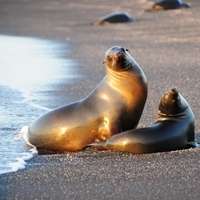Techniques for analysing smart phone data may help researchers understand marine species

Over the past 30 years, satellite tracking has revealed the otherwise invisible lives of the animals that occupy the skies, forests and oceans - and now scientists hope to apply the latest techniques used to understand how humans move, to learn even more about the migrations of the biggest marine animals.
A team of researchers from The Australian Institute of Marine Science (AIMS) and The University of Western Australia is leading this research.
While tracking animals began in the 1950s, in contrast, studies of human mobility have only been a very recent development. These are made possible by the fact that we carry our own personal GPS system - a smart phone - which over time has generated huge datasets about human behaviour and provides opportunities to understand human movement on a global scale.
These large datasets, and the novel analyses used, highlight an opportunity that can be applied to understanding the movements of marine megafauna, one of the key groups for which a large amount of tracking data exists.
In a workshop to be held in Perth next week, researchers from the UWA Oceans Institute and AIMS will pose the question, 'how can we apply new approaches to studying human mobility to the monitoring of marine megafauna globally?'
A group of renowned national and international multidisciplinary researchers, including physicists, animal biologists and ecologists, will attend the 'Marine Megafauna Synthesis Group' workshop to share their data and work together to compare the movements and behaviours of these animals on a global scale, using novel approaches from the study of human mobility.
The tracking data from marine mammals, birds, reptiles and large fishes will be collated and synthesised, with the intention of providing new insights into their movement and behaviour as well as preparing a roadmap for developing a publically available data storage facility for animal tracking data.
The many small-scale projects have resulted in hundreds of thousands of individual animals being tracked over time and combining all these data in such a facility would allow for significant advances to be made.
AIMS Research Scientist and UWA Adjunct Assistant Professor, Dr Michele Thums, said the synthesis group presented a unique approach to advance our knowledge about the movements of megafauna worldwide, by data sharing and applying the approaches developed by scientists studying human mobility.
"Early satellite tracking data from albatrosses was an inspiration for the study on how humans move in the environment. Even though our discipline of studying animal movement has been around longer, it has been overtaken in terms of advancements given the access to large data brought about by the internet and smart phones. Data sharing would allow us to reach the same level of understanding," Dr Thums said.
UWA Research Associate Dr Ana Sequeira said that involving a multi-disciplinary group to analyse such data and pose questions from their multiple perspectives would assist in promoting advances not only in ecology but also in other disciplines.
Dr Thums and Dr Sequeira are also involved in UWA's first crowd-sourcing campaign in two separate projects involving the tracking of turtle hatchlings and on a larger scale, the whale sharks at Ningaloo. Both projects have huge community appeal and provide opportunities for the community to become involved in marine research involving monitoring of marine megafauna.
Professor Daniel Costa from the University of California, a key participant in the working group, has been a pioneer in tracking marine megafauna movements and behaviour using telemetry for many years. He co-founded the Tagging of Pacific Predators Program, a multidisciplinary effort to study the movement patterns of 23 species of marine vertebrate predators in the North Pacific Ocean.
"Some of the most exciting advances in our field have come from the interaction across disciplines," said Professor Costa. "This meeting will bring together individuals who know how to tag marine animals with individuals who are adept at analysing large data sets. Together we should gain new insights into our data that we could never have achieved on our own.
Provided by University of Western Australia



















